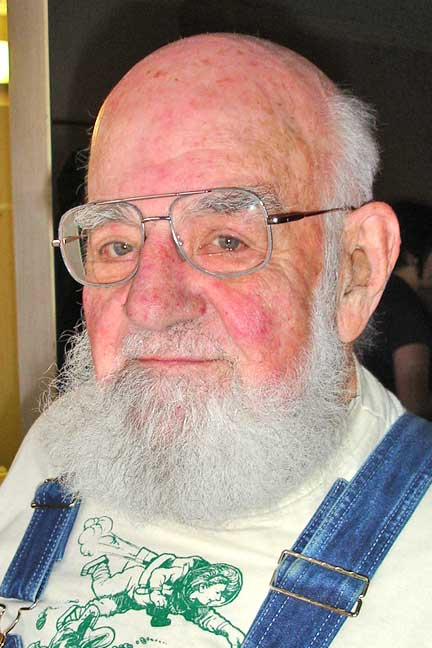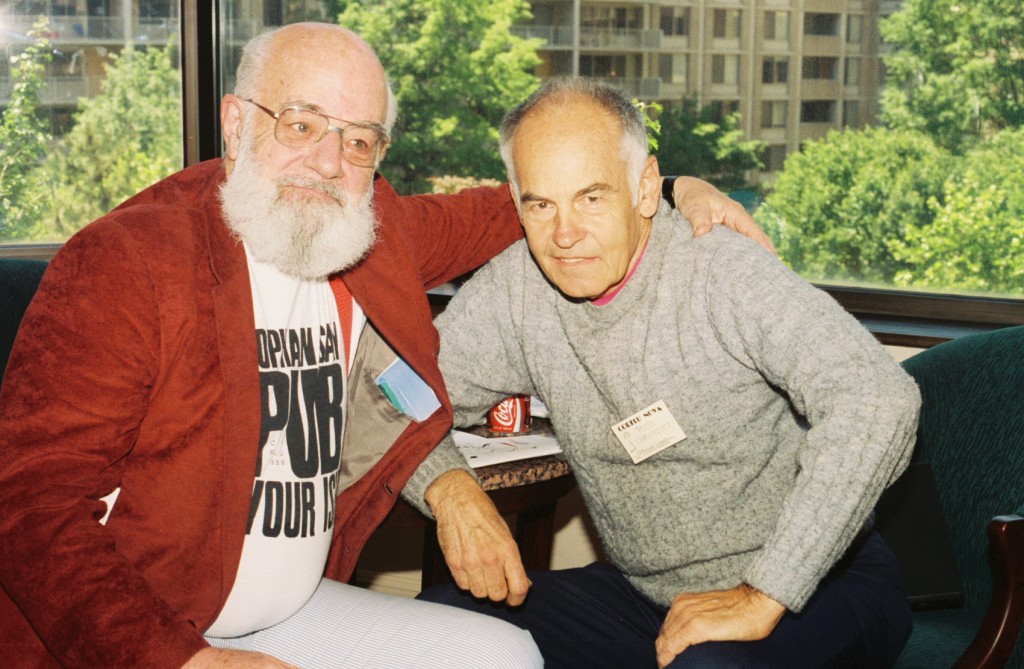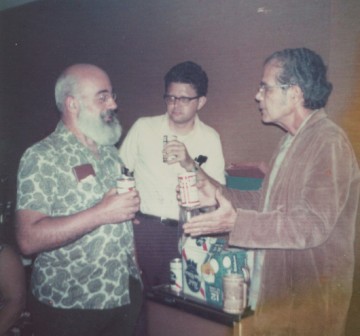Always ready to help, never a better friend, opinionated, long on experience and wise about fannish weaknesses (even his own), a fascinating storyteller, organizer and party host, Art Widner passed away April 17 at the age of 97.
Widner wrote not long ago that he had prostate cancer, which had spread to his bones, reports Andrew Porter. He had outlived his children, but is survived by several grand-and great-grandchildren.
Art himself lived two complete fan lifetimes, interrupted by a three-decade gafiation.
His first fannish life began when he discovered fandom through the prozines. And that life was characterized by a zeal for fanpolitics and organizing.
“Like so many fen, I was the Old Weird Harold on my block, carrying home those lurid pulp magazines with nubile bimbos on the cover wearing VW hubcap bras – which was remarkable because Volkswagen hadn’t been invented yet,” he told the audience at the 1989 Worldcon’s “Family Reunion.”
As other proto-fans did in the 1930s, he wrote letters to the prozines reviewing their efforts and criticizing their shortcomings – many of them to Weird Tales.
He helped organize “The Stranger Club” in 1940, Boston’s first science fiction club, together with Louis Russell Chauvenet, Chandler Davis, Gertrude Kuslan, Louis Kuslan, Norman Stanley, R.D. Swisher, and others. He chaired the city’s first two sf conventions, Boskone I (1941) and Boskone II (1942). He published his first fanzine, co-edited with Earl Singleton and Francis Paro, FanFare.
Along with Louis Russell Chauvenet and Damon Knight, he was responsible for the formation of the National Fantasy Fan Federation (N3F). Supporting Damon Knight’s call for a national fan organization, Widner wrote in FanFare in 1940, “The crying need is cooperation among all fans and this seems an impossible situation at present. Fandom should have some sort of united front to put toward the rest of the world, or it will continue to be regarded as just the juvenile goshwowoboyoboy gang.”
He was also one of the big name fans on the board of directors of the Fantasy Foundation announced at the 1946 Worldcon, touted by Forry Ackerman as a museum of imaginative literature.
As a young man Art was reputed to be Built Like A Gorilla. Robert Madle was grateful to have him on hand at the 1941 Worldcon when C.M. Kornbluth was in a violent mood:
He [Kornbluth] was the arrogant one of the group, the one who had a personality like a snake. Not to cut him down his writings, which are very excellent. But he had a peculiar personality. Like there was that night they were going to beat the shit out of me at one of the conventions.
Fortunately I had with me Art Widner. We used to call him Popeye because he had muscle bulging out of his arms. Kornbluth said, “Hey, I’m going to beat the shit out of Madle,” and Widner said, “Who’s going to beat the shit out of who?”
I think that was the Denver convention. Other than that I had no real problems with Kornbluth – other than that night when he decided to beat the shit out of me.
(From C.M. Kornbluth: The Life and Works of a Science Fiction Visionary by Mark Rich.)
He was regarded a member of the Fantasy Amateur Press Association (FAPA) Brain Trust, a colloquial name for those who engaged in weighty discussions. On the other hand, nobody liked a good time better.
Widner featured in the 1940 Worldcon masquerade as Giles Habibula, his costume constructed out of “Pogo’s hat, Trudy Kuslan’s pillow, and an anonymous bartender’s wine bottle.” He returned in 1941 as “Old Granny” from Slan.
But often Art was looking for something beyond simple fun. He is credited with creating the first original science fiction board game, Interplanetary (1943), which he described as —
a combination of a standard [auto] “race” game and Monopoly. One had to get to a planet and bring back a cargo in order to finance a trip to the next distant planet where a still more valuable cargo would be obtained, etc., out to Pluto, which harbored “Immortality Dust,” the game winner. The novel aspect was that the planets moved, making it difficult to land on one, plus such hazards as the “negasphere”. (from EESmith epics–now known as a black hole) and pirates, to say nothing of falling into the sun, getting hit with space junk, etc.
With all these complexities, it took 8-12 hours to complete a game. Using a streamlined set of rules, it became popular with fans again in the 1960s. LASFS still owns a giant Interplanetary board and has hosted games in recent decades.
Art’s literary output was limited to a single prozine sale, “The Perfect Incinerator”, under the name Arthur Lambert, that appeared in a 1942 issue of Robert Lowndes’ Science Fiction Quarterly (priced, appropriately, for a quarter.)
Widner was the most inveterate poll taker in early 1940s fandom. The Widner Poll of 1940 included a list of the top ten science fiction pulps voted on by fans. When a gloating reader pointed out to editor Ray Palmer that not one belonged to Ziff-Davis, which published Palmer’s magazine, he dismissed it, saying that although Widner’s poll may have represented a dozen fans, Ziff-Davis circulation figures showed its magazines represented several hundred thousand readers from all walks of life, all over the world.
A few years later Art launched Poll Cat, chronicled by Jack Speer in Fancyclopedia I:
Originally it was simply concerned with preferences among stf authors, etc. Appeals were broadcast in all leading fanzines for readers to send in their votes on certain questions, and as returns were compiled, they were published, later returns being published later. Then one issue of a fanzine called The Poll Cat appeared, at which time Widner set out to test the thesis that fans are a separate and distinct type (slans or whatever you want to call them)….Looking for unusual average in fans, Widner found several characteristics that looked significant, such as longevity of grandparents, larger hat size, and greater height….
Art attended the first Worldcon in New York in 1939, and the next four, in Chicago (1940), Denver (1941), Los Angeles (1946) and Philadelphia (1947).
He drove to the Chicago Worldcon in a 1928 Dodge, the Skylark of WooWoo, the last model made by the Dodge Brothers.
He made an epic cross-country trek to Denvention I — the Widneride — in the FooFoo Special, a car without a trunk, accompanied by “Moneybags Unger, Tree Toad Rothman, Pretty Boy Madle, [and] Sourpuss Bell.”
(Now that Widner has passed away, only four people remain alive who attended the first Worldcon: Dave Kyle, Bob Madle, Erle Korshak and Jack Robins.)
Widner married during World War II, then was drafted into the service. However, because he was “volunteered” to be a technician-guinea pig at the newly formed Climatic Research Lab in Lawrence, MA he still got to go home nearly every weekend.
His fanac slowed while he was in the military and ground to a halt when he moved his family to Los Angeles in 1948. Soon after that he gafiated completely.
Signifying his disappearance from fandom, although Art is constantly mentioned in Warner’s 1940s history All Our Yesterdays, he doesn’t have a single listing in the index of the sequel about the 1950s, A Wealth of Fable.
Widner reappeared in fandom in the 1970s – reminiscing that like Voyager 2 after 10 years he had explored the local system, science fiction fandom, and went to see what lay beyond. “Thirty-five years later I came back to report: it’s pretty lonely out there.” He returned to fandom as an “eo-neo” and bumped into Patrick and Teresa Nielsen Hayden “who knew who I was – or rather, had been.”
His best known fanzine YHOS, first published from 1940 till 1945, resumed publication after a 34 year hiatus and remained a prominent faanish zine into the 1980s and 1990s. (Even Harlan Ellison read it – something Art learned when Harlan phoned his cabin early one morning to take exception to a story Art had run.)
Originally revived as Art’s FAPAzine in 1979, YHOS consisted mainly of personal reminiscences about 1940s fandom and mailing comments. Then it started to fill out with long travel reports, the kind of thing it was known for in its original incarnation. There was a “special travel issue” about Art’s trip to the ’79 Worldcon in Britain, a report on a trip to China, and another about his visit to Australia. In time, it took on all the features of a genzine, with a host of original contributions and classic reprints.
Art also visited the Soviet Union in 1978 with a fan tour group that included Forry Ackerman, Joe and Gay Haldeman, Art Widner, Clifton Amsbury and Charles N. Brown.
And he enjoyed sidling up to folks who hadn’t seen him since the 1940s to see if they recognized him:
I believe it was at a Norwescon that I wandered into the SFWA suite and spotted Damon Knight and Kate Wilhelm sitting by themselves waiting for something to happen…. We had both changed considerably, and I only recognized him because he was famous and had his picture in Locus. He didn’t recognize me as I sat down nearby. I kept mum and gave him a chance to see past the wrinkles and gray beard, but he apparently decided it wasn’t worth the effort and resumed talking to Kate.
Finally I introduced myself and he cracked up. Turning to Kate, he said, “I’d like to have you meet the guy who helped me start the dumbest organization in all fandom.”
That was the N3F. But when he resumed going to Worldcons Art said he was “quite astonished [to find] that the NFFF was still alive and kicking. Not only that, but the good-hearted fuggheads running the Welcome Room were pathetically eager to induct me into the mysteries of Trufandom about which they didn’t know a blessed thing!”
He attended the first 18 Corflus without a miss. A classic moment at the 2008 edition was Art serenading his fellow eo-fan, Jack Speer, with the first-ever filksong, written by Jack himself.
Although the term “filksong” had yet to be invented, several of these songs were sung at the 1940 Worldcon. Jack created them by setting new lyrics with a science fictional theme to familiar tunes. A snippet of one goes:
We’ll build a tempo-ship
And we’ll take a little trip,
And watch a million years go by.
You can still hear Art Widner’s mellow tones in Bill Mills’ Voice of Fandom podcast #16.
The 2007 Ditto was organized around Art’s 90th birthday and held in his hometown of Gualala, California. “I have never seen that much alcohol in a con suite, maybe even counting Midwestcon,” recalled Hope Leibwoitz in her conreport. “At the birthday party, there were 15 bottles of scotch on the table.” Art was a great fan of good scotch. People toured his eight-sided green-painted house. At one point in the con, Art read the 10 things it took him 90 years to learn, eventually published in Yhos.
He later added a new #3, in “R. Twidner”-style:
It’s specificly directed at the Religiosity Ryt. ‘Forget John 3:16. Read Matthew 23’ It’s what Jesus thot of the Philistines, scribes & harisees, i.e., Big Time Hypocrits.
(Michael Ward’s photos of Art’s 90th Birthday party are online: Friday, Saturday, and Sunday, plus Saturday Dinner at St. Orres, Art’s House, a visit to Bowling Ball Beach, and Picturesque Scenes from Gualala, California, and The Breakers Inn.)
Art was a guest of honor at many other conventions: Boskone IV (1945), Noreascon 3 (1989, as part of The Strangers Club), Norwescon VI (1983), Westercon 43 (1990), Minicon 25 (1990), Corflu 16 (1999), Ditto 19 (2007) and twice at BayCon.
A member of First Fandom and the First Fandom Hall of Fame, he was honored with the Big Heart Award in 1989, and in 2001 was selected at Corflu as Past President of the Fan Writers of America for 2000. Along with the other members of The Stranger Club, he was Fan Guest of Honor at Noreascon 3. He was nominated for the 1946 Best Fan Writer Retro Hugo at L.A.con III in 1996. He received a Special Lifetime Achievement Award at Corflu in 2011.
He was voted Down Under Fan Fund delegate in 1991 and attended the Australian NatCon.
Glenn Glazer aptly commemorated Art Widner’s passing with this quote from The Hobbit:
‘No!’ said Thorin. ‘There is more in you of good than you know, child of the kindly West. Some courage and some wisdom, blended in measure. If more of us valued food and cheer and song above hoarded gold, it would be a merrier world.
Freed of the ambitions of his first fannish life, the second time around Art knew exactly how to make this a merrier world. He set a great example for the rest of us.
Update 04/27/2015: Added Jack Robins as a surviving fan who attended the first Worldcon in 1939. Thanks to John Coker III for the correction.







